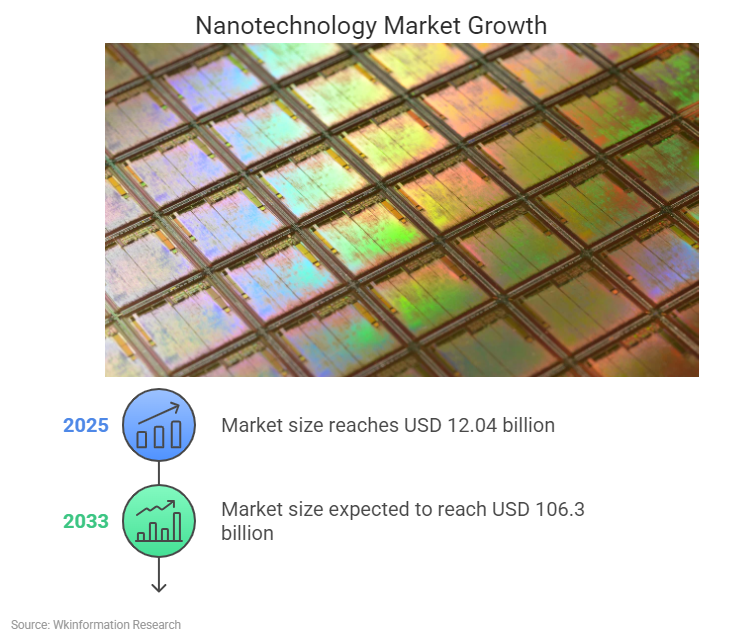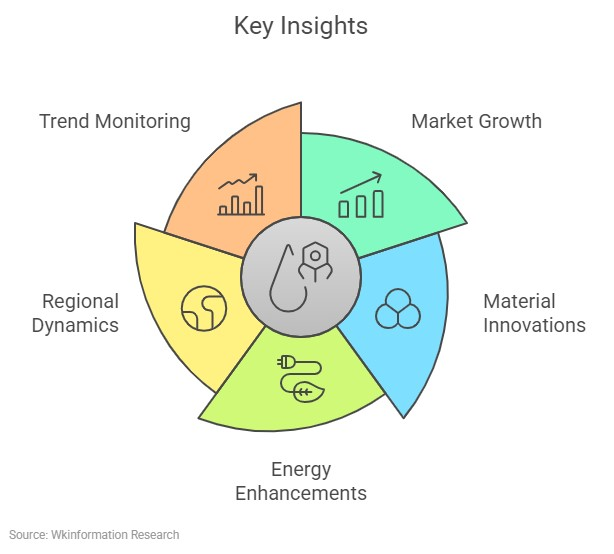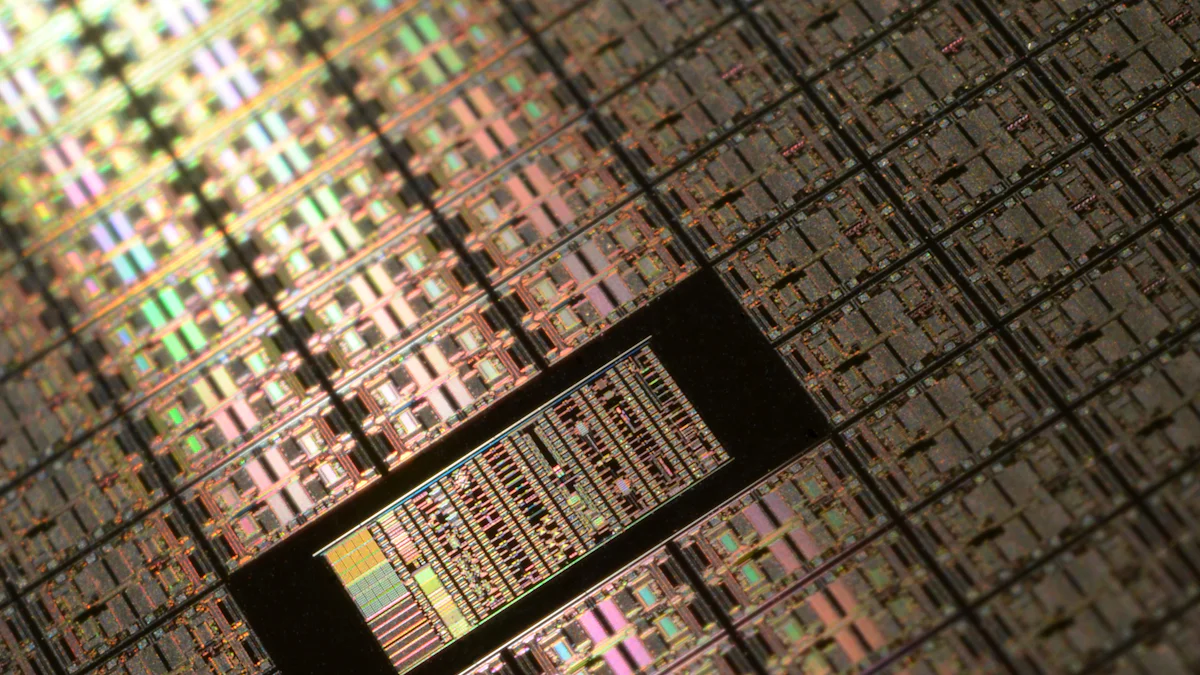
Nanotechnology continues to revolutionize industries, driving innovation and economic growth. Between 2025 and 2033, the nanotechnology market is projected to grow at a remarkable CAGR of 31.29%, with its market size reaching $106.3 billion by 2033. This growth stems from advancements in nanotechnology research, particularly in medical diagnostics and nanotech devices. Increased government funding and support further fuel this expansion. However, challenges like deploying nanotech devices in extreme weather conditions persist. Understanding nanotechnology trends is crucial for stakeholders aiming to leverage its potential. By staying informed, they can align with key trends and capitalize on emerging opportunities in nanoscience.
Key Insights
- Nanotechnology is growing fast and may reach $106.3 billion by 2033. This growth is due to better research and more government help.
- Carbon-based nanomaterials and bio-nanomaterials are changing industries. They improve electronics, healthcare, and eco-friendly solutions.
- Nanotechnology boosts renewable energy and energy storage. It makes solar panels and batteries work better.
- North America leads in nanotechnology ideas. Asia-Pacific is becoming a big place for making products, showing how regions matter.
- People need to follow nanotechnology trends to find new chances and support green growth.

Emerging Trends in the Nanotechnology Market

Innovations in Nanomaterials
Carbon-based nanomaterials and their applications
Carbon-based nanomaterials are transforming industries with their unique properties. Graphene and carbon nanotubes, for instance, are widely used in electronics for their exceptional conductivity and strength. These materials also play a pivotal role in carbon capture technology, aiding in the reduction of greenhouse gas emissions. In construction, integrating graphite properties into concrete enhances mechanical strength while supporting decarbonization efforts. Additionally, nanocomposites like carbon fiber-reinforced polymers (CFRP) are revolutionizing the automotive and aerospace sectors by offering lightweight yet durable solutions.
Bio-nanomaterials for healthcare and sustainability
Bio-nanomaterials are gaining traction in biomedical applications due to their compatibility with living tissues. These materials are instrumental in drug delivery systems, enabling targeted therapies with minimal side effects. Nanoencapsulation techniques further enhance the precision of treatments by protecting active ingredients until they reach their target. In sustainability, biofabrication methods are emerging as clean technology alternatives, reducing reliance on harmful chemicals in manufacturing processes. These advancements highlight the role of nanotechnology in addressing both healthcare and environmental challenges.
Expanding Applications of Nanotechnology
Growth in renewable energy and energy storage solutions
Nanotechnology in energy applications is driving the shift toward renewable energy. Nanomaterials improve the efficiency of solar panels and catalysis processes for hydrogen fuel production. In energy storage, nanocomposites enhance battery performance, enabling longer lifespans and faster charging. These innovations align with cleantech goals, promoting cleaner and more sustainable energy sources.
Advancements in drug delivery and medical diagnostics
Nanotechnology trends in healthcare focus on precision and efficiency. Drug delivery systems leverage nanoencapsulation to transport medications directly to affected areas, reducing dosage requirements and side effects. In diagnostics, nanoscale devices enable early detection of diseases through advanced imaging techniques. These biomedical applications are revolutionizing patient care by improving treatment outcomes and reducing healthcare costs.
Sustainability and Environmental Impact
Development of eco-friendly nanomaterials
Eco-friendly nanomaterials are at the forefront of clean technology. Greener synthesis methods and biofabrication techniques minimize environmental impact during production. Nanocomposites like metal-organic frameworks (MOFs) are used in carbon capture technology, offering scalable solutions for reducing industrial emissions. These developments underscore the importance of nanotechnology in achieving sustainability goals.
Nanotechnology’s role in achieving sustainability goals
Nanotechnology supports cleantech initiatives by addressing critical environmental issues. For instance, iron oxide nanoparticles effectively remove heavy metals from wastewater, while graphene oxides eliminate pharmaceutical waste. Thin-film membranes with nanopores enhance water purification and desalination processes, providing energy-efficient solutions. These applications demonstrate how nanoscience contributes to a cleaner and more sustainable future.
Market Share Analysis in the Nanotechnology Market
Key Players
- Heenrgy Biotech
- Roche
- DuPont de Nemours
- 3M
- Altair Nanotechnologies
- Bayer Material Science
- Hewlett-Packard
- GE Healthcare
- Parker Hannifin
- Fujitsu laboratories
- Abbott
- …… (More Player will show in our freesample)
Sector-Wise Market Insights
Dominance of healthcare and electronics sectors
The healthcare and pharmaceuticals sector leads the nanotechnology market. This dominance stems from advancements in diagnostics, regenerative medicine, and drug delivery systems. The electronics sector also plays a pivotal role, driven by the demand for miniaturized and high-performance devices.
- Healthcare and pharmaceuticals dominate due to nanotechnology’s role in disease monitoring, vaccine development, and surgical devices.
- Electronics benefit from nanomaterials that enhance device efficiency and durability.
Growth in agriculture, construction, and other sectors
Nanotechnology applications are expanding into agriculture and construction. In agriculture, nanocomposites improve crop yield and pest control. In construction, nanomaterials enhance the durability and sustainability of building materials. These sectors, alongside aerospace and defense, contribute to the growing nanocomposites market.
Investment and Funding Trends
Role of venture capital and government funding
Venture capital plays a crucial role in funding nanotechnology innovations. Corporate venture capital arms invest in start-ups to align with strategic goals. However, government funding and corporate R&D dominate the sector, ensuring the transition of nanoscience from research to commercialization.
Regional disparities in investment levels
Investment levels in nanotechnology vary significantly across regions. Public-private partnerships and state-level initiatives influence funding availability. Regions with robust government support and venture capital ecosystems experience faster commercialization of nanotechnology innovations. These disparities highlight the need for international collaboration to bridge gaps in funding and development.
Technological Advancements and Applications in Nanotechnology

Breakthrough Innovations in Nanotechnology
Nanosensors for IoT and smart devices
Nanosensors are revolutionizing IoT and smart device applications by enhancing functionality and energy efficiency. These sensors enable real-time monitoring of environmental and industrial phenomena, providing critical data for IoT systems. For instance, a flexible nanowire-based sensor developed by Tang et al. (2019) demonstrates superior detection limits and faster response times for ammonia monitoring compared to traditional sensors. With power consumption as low as 3μW, nanosensors offer scalable fabrication techniques, making them ideal for widespread adoption in IoT devices. Their ability to improve accuracy and reduce energy usage aligns with cleantech goals, further solidifying their role in modern technology.
Nanorobotics for precision medicine and surgery
Nanorobotics represents a groundbreaking advancement in healthcare, particularly in precision medicine and surgery. These nanodevices operate at the molecular level, enabling hyper-targeted drug delivery and minimally invasive surgical procedures. For example, nanoparticle-based vaccines and therapeutic agents can be delivered directly to diseased cells, reducing side effects and improving treatment outcomes. Nanorobots also assist in real-time diagnostics, offering unparalleled accuracy in detecting and treating conditions like cancer. This innovation underscores the transformative potential of nanotechnology in addressing complex medical challenges.
Applications Across Key Industries
Miniaturization and performance enhancement in electronics
Nanotechnology plays a pivotal role in the miniaturization of electronic devices while enhancing their performance. Nanomaterials such as graphene and nanocomposites improve conductivity, durability, and energy efficiency in semiconductors and microchips. These advancements enable the development of compact, high-performance devices, meeting the growing demand for portable and efficient electronics. By integrating nanodevices into consumer electronics, manufacturers achieve superior functionality without compromising size or weight.
Water purification and environmental monitoring solutions
Nanotechnology offers innovative solutions for water purification and environmental monitoring. Engineers have developed thin-film membranes with nanopores that enhance desalination efficiency, filtering more water than traditional methods. Nanoparticles neutralize industrial pollutants in groundwater, providing a cost-effective alternative to conventional treatments. Additionally, magnetic water-repellent nanoparticles and nanofabric materials, such as potassium manganese oxide-based “paper towels,” effectively address oil spill remediation and environmental cleanup. These applications highlight the role of nanotechnology in advancing cleantech initiatives and ensuring sustainable resource management.
Challenges and Opportunities
Addressing scalability and cost challenges
Scaling up nanotechnology production presents significant challenges. Controlling the characteristics of nanomaterials during large-scale manufacturing remains difficult. Industrial R&D companies often hesitate to invest in these techniques without guaranteed profitability. Financial and technological barriers further hinder the commercialization of nanodevices. Overcoming these obstacles requires collaborative efforts between researchers, governments, and private sectors to develop cost-effective and scalable solutions.
Ethical and regulatory considerations in nanotechnology
The rapid growth of nanotechnology raises ethical and regulatory concerns. Issues such as surveillance, privacy, and the potential misuse of nanodevices demand careful oversight. Policymakers face challenges in creating and enforcing regulations across diverse applications. Key stakeholders, including government agencies, researchers, and the public, must collaborate to establish guidelines that minimize risks while fostering innovation. Suggested actions include banning certain high-risk R&D activities, forming regulatory commissions, and adopting design standards to ensure ethical practices.
Regional and Global Dynamics of the Nanotechnology Market
Regional Trends in Nanotechnology
North America’s leadership in R&D and innovation
North America leads the global nanotechnology market, accounting for over 38% of the market share in 2024. This dominance stems from significant investments in nanotechnology research and development. Governments in the region allocate substantial funding to foster innovation in healthcare, IT, and manufacturing. The United States, in particular, drives advancements in nanomaterials and nanotechnology applications, supported by collaborations between academic institutions and private enterprises. These efforts position North America as a global leader in nanotechnology trends and innovation.
Asia-Pacific’s role as a manufacturing and innovation hub
Asia-Pacific emerges as the fastest-growing region in the nanotechnology market, driven by government investments in the energy and power sectors. Countries like China, India, South Korea, and Japan experience high demand for nanomaterials due to their robust manufacturing capabilities. Emerging economies in the region adopt advanced technologies to enhance nanotechnology manufacturing. The integration of IoT with nanotechnology creates interconnected systems that improve performance. Additionally, businesses in Asia-Pacific emphasize sustainability by adopting eco-friendly technologies to minimize waste.
Global Economic Impacts of Nanotechnology
Influence on global trade and supply chains
Nanotechnology reshapes global trade and supply chains by enhancing product quality and safety. The market is projected to grow from $12.04 billion in 2025 to $106.3 billion by 2033. Increased demand for nanomaterials in industries like healthcare, aerospace, and electronics drives this expansion. Developing countries in Asia-Pacific play a pivotal role in this growth, leveraging government support and funding to integrate nanotechnology into supply chains. These advancements highlight nanotechnology’s transformative impact on global trade dynamics.
Policy and Regulatory Landscape
Government policies shaping the nanotechnology market
Government policies play a crucial role in shaping the nanotechnology market. Funding initiatives, such as grants and tax breaks, encourage investment in nanotechnology projects. Institutions like MIT and Stanford foster collaborations between academia and industry, accelerating innovation. Countries like Canada, China, Japan, and South Korea actively pursue nanotechnology advancements, creating a competitive global landscape.
International collaboration and standardization efforts
International collaboration is essential for advancing nanotechnology research and ensuring its safe application. Standardization efforts focus on creating global guidelines for nanomaterials production and usage. These initiatives aim to address ethical and regulatory challenges while fostering innovation. Collaborative projects between nations enhance knowledge sharing and accelerate the commercialization of nanotechnology solutions.
Emerging Opportunities in Nanotechnology
Integration with AI, quantum computing, and space exploration
Nanotechnology is set to revolutionize emerging fields like artificial intelligence, quantum computing, and space exploration. Lightweight, high-strength nanomaterials will enable the construction of durable spacecraft and tools for deep-space missions. In AI, nanosensors will enhance data collection and processing, while quantum computing will benefit from nanotechnology’s ability to create precise and efficient components. These integrations will unlock new possibilities in cosmology, energy solutions, and advanced manufacturing.
Potential for new applications in unexplored sectors
Nanotechnology trends indicate significant potential in unexplored sectors.
- Carbon nanotube membranes will improve carbon dioxide separation from industrial exhaust.
- Advanced nanoparticles will enhance fuel efficiency in vehicles and power plants.
- Flexible solar cells and piezoelectric nanowires will drive innovations in renewable energy.
- Nanotechnology will also transform air and water purification systems, offering advanced filtration and contaminant detection solutions.
These applications demonstrate the versatility of nanotechnology in addressing global challenges.
Addressing Future Challenges
Overcoming technical and regulatory barriers
The nanotechnology market faces challenges related to health, safety, and environmental impacts. Effective regulatory measures must address these concerns while ensuring sustainability across the lifecycle of nanomaterials. Collaborative efforts between governments, researchers, and industries will be essential to establish guidelines that balance innovation with safety.
Ensuring equitable access to nanotechnology advancements
Equitable access to nanotechnology remains a critical issue. Initiatives like the Access to COVID-19 Tools (ACT) Accelerator highlight the importance of making advancements accessible to vulnerable populations, particularly in developing nations. Promoting “nanoequity” through global collaboration will ensure that the benefits of nanotechnology reach all regions, fostering inclusive growth.
Overview
Nanotechnology continues to redefine industries by introducing groundbreaking innovations and applications. Key trends, such as advancements in carbon nanomaterials and nanosensors, highlight its growing influence across sectors like healthcare, electronics, and energy. Stakeholders must monitor these developments to remain competitive and capitalize on emerging opportunities.
Staying informed about nanotechnology trends ensures businesses can adapt to evolving market demands. As the global economy increasingly relies on nanotechnology, its ability to drive sustainability, enhance efficiency, and foster innovation will continue to shape the future. By embracing these advancements, industries can unlock new possibilities and achieve unprecedented growth.
| Report Metric | Details |
|---|---|
| Report Name | Global Nanotechnology Market Report |
| Base Year | 2024 |
| Segment by Type |
· Nanomaterials · Nanotools · Nanodevices · Others |
| Segment by Application |
· Medicine and Healthcare Diagnosis · Environment · Energy · ICT · Nano-EHS · Others |
| Geographies Covered |
· North America (United States, Canada) · Europe (Germany, France, UK, Italy, Russia) · Asia-Pacific (China, Japan, South Korea, Taiwan) · Southeast Asia (India) · Latin America (Mexico, Brazil) |
| Forecast units | USD million in value |
| Report coverage | Revenue and volume forecast, company share, competitive landscape, growth factors and trends |
FAQ
What industries benefit the most from nanotechnology advancements?
Healthcare, electronics, and energy sectors benefit significantly from nanotechnology. Applications include drug delivery systems, miniaturized electronic devices, and renewable energy solutions. These industries leverage nanotechnology to enhance efficiency, sustainability, and innovation.
How does nanotechnology contribute to sustainability?
Nanotechnology supports sustainability by enabling eco-friendly materials, improving energy efficiency, and reducing waste. For example, nanomaterials enhance water purification processes and carbon capture technologies, addressing critical environmental challenges.
What are the key challenges in scaling nanotechnology?
Scaling nanotechnology faces challenges like high production costs, maintaining material consistency, and regulatory hurdles. Collaborative efforts between researchers, industries, and governments are essential to overcome these barriers and ensure commercialization.
Which regions lead in nanotechnology innovation?
North America leads in research and development, while Asia-Pacific excels in manufacturing and adoption. Countries like the United States, China, and Japan drive advancements through investments and robust industrial ecosystems.
How does nanotechnology impact global trade?
Nanotechnology enhances product quality and safety, reshaping global trade dynamics. Industries like healthcare, aerospace, and electronics integrate nanomaterials, driving demand and fostering international collaboration in supply chains.
Global Nanotechnology Market Report (Can Read by Free sample) – Table of Contents
Chapter 1: Nanotechnology Market Analysis Overview
- Competitive Forces Analysis (Porter’s Five Forces)
- Strategic Growth Assessment (Ansoff Matrix)
- Industry Value Chain Insights
- Regional Trends and Key Market Drivers
- Nanotechnology Market Segmentation Overview
Chapter 2: Competitive Landscape
- Global Nanotechnology Players and Regional Insights
- Key Players and Market Share Analysis
- Sales Trends of Leading Companies
- Year-on-Year Performance Insights
- Competitive Strategies and Market Positioning
- Key Differentiators and Strategic Moves
Chapter 3: Nanotechnology Market Segmentation Analysis
- Key Data and Visual Insights
- Trends, Growth Rates, and Drivers
- Segment Dynamics and Insights
- Detailed Market Analysis by Segment
Chapter 4: Regional Market Performance
- Consumer Trends by Region
- Historical Data and Growth Forecasts
- Regional Growth Factors
- Economic, Demographic, and Technological Impacts
- Challenges and Opportunities in Key Regions
- Regional Trends and Market Shifts
- Key Cities and High-Demand Areas
Chapter 5: Nanotechnology Emerging and Untapped Markets
- Growth Potential in Secondary Regions
- Trends, Challenges, and Opportunities
Chapter 6: Product and Application Segmentation
- Product Types and Innovation Trends
- Application-Based Market Insights
Chapter 7: Nanotechnology Consumer Insights
- Demographics and Buying Behaviors
- TargetAudience Profiles
Chapter 8: Key Findings and Recommendations
- Summary of Nanotechnology Market Insights
- Actionable Recommendations for Stakeholders


